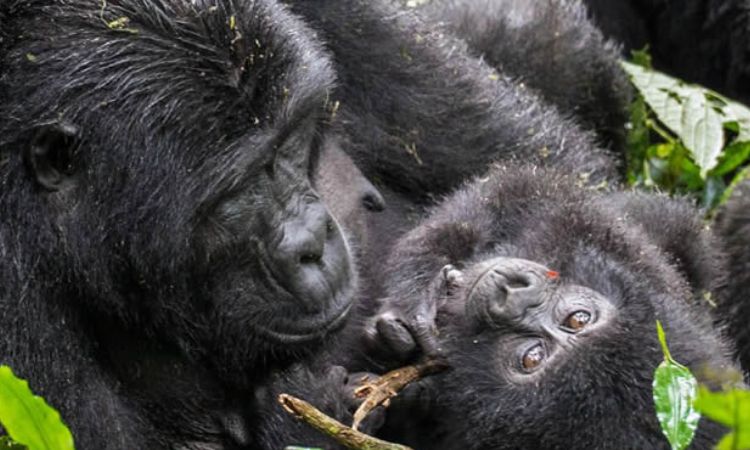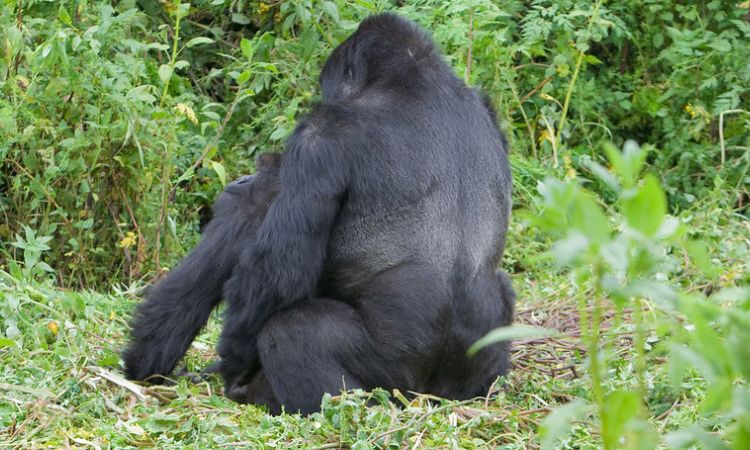Intriguing Secrets and 5 Facts About Gorilla Mating Rituals
Gorilla Mating: Discover how gorillas mate — the positions they prefer, how long they last, the meaning behind their mating behavior, whether they enjoy it, how it compares to humans, and more in this comprehensive guide.
Introduction:
Gorillas, our closest primate relatives, captivate us with their complex social structures and behaviors, particularly their mating habits.
Gorilla mating offers a window into their intricate family dynamics, emotional intelligence, and survival strategies. Lets dive into the fascinating world of gorilla reproduction, exploring courtship, family roles, and conservation, while addressing common curiosities like mating positions, interspecies interactions, and similarities to human behavior.
Whether you’re a wildlife enthusiast or planning a gorilla trekking adventure, this guide provides a comprehensive, scientifically accurate look at gorilla mating.
Gorilla Mating Behavior Overview
Gorillas, primarily mountain and lowland species, live in tight-knit family groups led by a dominant silverback. Their mating system is polygynous, meaning one male mates with multiple females in his troop.
Gorilla reproduction is a cornerstone of their social structure, ensuring the survival of their lineage. Key facts include:
- Female Gorillas reach sexual maturity at 8–10 years, while males mature around 12–15 years, often becoming silverbacks later.
- Mating occurs year-round, as gorillas lack a specific mating season.
- The silverback maintains exclusive mating rights within his group, though challenges from younger males can disrupt this.
This non-seasonal mating allows flexibility in gorilla reproduction, ensuring steady population growth despite environmental challenges. Understanding these basics sets the stage for exploring the silverback’s critical role.
Role of the Silverback in Mating
The silverback gorilla is the undisputed leader of the troop, and his role in silverback gorilla mating habits is pivotal. As the dominant male, he:
- Mates with all sexually mature females in the group, ensuring his genes dominate.
- Protects the troop from rival males and predators, securing his mating privileges.
- Maintains order through displays of strength, such as chest-beating or vocalizations.
Younger males, known as blackbacks (males aged 8–12 who haven’t yet developed silver fur), rarely mate within the troop. Instead, they may leave to form their own groups or challenge the silverback for dominance. This gorilla dominance hierarchy ensures only the strongest males pass on their genes, a trait honed by evolution.
Gorilla mating with blackbacks occurs only if a blackback successfully overthrows the silverback or forms his own troop. These power struggles are rare but intense, often involving physical confrontations that establish the new leader.

Gorilla Courtship and Mating Behavior
Gorilla courtship is subtle yet deliberate, often initiated by females. Contrary to popular belief, gorilla mating is not purely male-driven. Female gorilla mating behavior includes:
- Approaching the silverback with specific gestures, such as prolonged eye contact or light touching.
- Presenting their hindquarters to signal receptiveness.
- Engaging in grooming or playful behaviors to strengthen bonds before mating.
The act of mating is brief, typically lasting 30 seconds to a minute. Gorillas prefer privacy, often retreating to dense vegetation for mating.
Gorilla mating positions vary, but the most common is the rear-entry position, where the female crouches, and the male mounts from behind.
However, gorillas mating face-to-face has been observed in some cases, particularly among mountain gorillas, mirroring a behavior seen in humans and bonobos. This position, though rare, highlights the emotional and social complexity of mountain gorilla mating rituals.
What do gorillas do when they want to mate? Females signal readiness through body language, while silverbacks may respond with gentle grunts or physical closeness. These interactions reflect a nuanced courtship process driven by mutual signals.
Do Gorillas Mate for Life?
A common question is, “Do gorillas mate for life?” The answer is no. While gorillas form strong social bonds within their troops, their mating system is not monogamous.
The silverback mates with multiple females, and females may leave the troop to join another if the silverback is overthrown or dies.
However, long-term bonds between a silverback and his females can develop, fostering stability in the gorilla family structure.
These bonds are built on mutual grooming, protection, and shared parenting responsibilities, creating a sense of unity despite the lack of lifelong pair-bonding.
Gorilla Reproduction and Gestation
Gorilla reproduction facts are vital for understanding their survival. After mating, the gorilla pregnancy period lasts approximately 8.5 months, closely resembling human gestation. Key reproductive details include:
- Females typically give birth to one infant, though twins are rare.
- Newborns weigh about 1.8–2 kg (4–4.5 lbs) and are entirely dependent on their mothers.
- Females nurse and care for infants for 3–4 years, during which they rarely conceive again due to lactational amenorrhea.
This slow reproductive rate makes gorilla populations vulnerable, as it takes years for a female to produce another offspring. Conservation efforts are critical to support healthy gorilla reproduction.
Infant Care and Parenting
Gorilla parenting is a testament to the species’ emotional depth. After birth, mothers carry infants on their chests for the first few months, later transitioning to their backs. Baby gorilla care involves:
- Constant physical contact to ensure safety and warmth.
- Nursing for up to three years, supplemented by solid food as the infant grows.
- Teaching social behaviors through play and observation.
The silverback plays a protective role, shielding infants from predators like leopards or rival males. This collective care within the troop underscores the strong gorilla family structure, where every member contributes to the young’s survival.
The affection displayed—hugging, grooming, and playful interactions—captivates observers and highlights gorillas’ intelligence.

Gorilla Mating Competition and Rivalry
Gorilla mating competition adds a layer of drama to their social dynamics. Rival blackbacks or external silverbacks may challenge the dominant male for control of the troop and its mating rights. These encounters involve:
- Displays of strength, such as chest-beating, roaring, or branch-breaking.
- Physical fights, though these are usually non-lethal, aimed at establishing dominance.
- Females occasionally choosing to follow a new silverback, especially if the current leader is weak or aging.
This gorilla hierarchy ensures that only the fittest males reproduce, strengthening the gene pool. Females may also migrate to new troops, seeking better protection or mating opportunities, which adds fluidity to group dynamics.
Similarities Between Gorilla and Human Mating Behavior
Curiosity about human vs gorilla mating stems from our shared ancestry. Gorillas and humans share about 98% of their DNA, and some mating behaviors reflect this closeness:
- Emotional bonds: Gorillas display affection through grooming, touching, and even kissing, similar to human courtship.
- Social structure: Both species prioritize group cohesion, with mating reinforcing social bonds.
- Face-to-face mating: While rare, gorillas mating face-to-face mirrors a position associated with emotional connection in humans.
However, gorilla mating is primarily instinct-driven, focused on reproduction and group survival, whereas human mating often involves complex emotional and cultural factors.
Questions like “Do female gorillas climax?” lack definitive answers, as research on primate orgasm is limited. Some studies suggest females may experience physical responses akin to pleasure, but this remains speculative.
Gorilla Mating with Other Animals or Humans
A common online query is whether gorillas mate with other animals or do gorillas mate with humans. Scientifically, these scenarios are impossible:
- Gorilla mating with other animals: Gorillas only mate within their species (Gorilla gorilla or Gorilla beringei). Cross-species mating, such as dog and gorilla mating, is biologically incompatible due to genetic differences. Such ideas often stem from myths or misinformation online.
- Gorilla mating with humans: Humans and gorillas cannot interbreed due to significant genetic barriers. While we share a common ancestor, our species diverged millions of years ago. Claims about human-gorilla mating are unfounded and often sensationalized. Learn More about Gorilla mating with Humans.
These clarifications address curiosity while maintaining scientific accuracy, helping dispel myths that could harm conservation narratives.
Gorilla Mating Time and Positions
Gorilla mating time refers to both the frequency and duration of mating. Gorillas mate year-round, with females becoming receptive during estrus cycles, which occur every 28–33 days if not pregnant or nursing.
How often do gorillas mate? Typically, a female mates every few years, aligning with her reproductive cycle and infant-rearing period.
The act itself is brief. How long do gorillas last during mating? Mating lasts 30 seconds to 2 minutes, with the silverback mounting the female quickly to conserve energy and minimize exposure.
In what position do gorillas mate? The most common is the rear-entry position, but gorilla mating positions can include face-to-face mating in rare cases, particularly among mountain gorillas. This versatility adds intrigue to mountain gorilla mating rituals, showcasing their behavioral complexity.
Where to See Gorillas in the Wild
For those inspired to witness gorilla mating behaviors firsthand, gorilla trekking offers an unparalleled experience. Top destinations include:
- Uganda: Bwindi Impenetrable National Park and Mgahinga Gorilla National Park, home to half the world’s mountain gorillas.
- Rwanda: Volcanoes National Park, known for its accessible gorilla trekking trails.
- Democratic Republic of Congo: Virunga National Park, offering unique gorilla encounters amidst stunning landscapes.
Conservation and Ethical Viewpoint
Gorilla conservation is critical, as mountain gorillas remain endangered, with only about 1,000 individuals left in the wild. Their slow reproductive rate—due to long gestation and infant-rearing periods—makes them vulnerable to threats like:
- Habitat loss from deforestation and human encroachment.
- Poaching and illegal trade.
- Diseases, including those transmitted by humans during trekking.
Ethical tourism, such as gorilla trekking Uganda, supports conservation by funding park management and research. Visitors must follow strict guidelines, like maintaining distance and wearing masks, to protect gorilla health. Supporting organizations like All Uganda Safaris contributes to efforts to save mountain gorillas.
FAQ: Common Questions About Gorilla Mating
- How often do gorillas mate?
Females mate every few years, depending on fertility cycles and infant-rearing periods. - Do gorillas have a mating season?
No, gorillas mate year-round, as they lack a specific breeding season. - How long is gorilla pregnancy?
The gorilla pregnancy period is about 8.5 months. - Who initiates mating, male or female?
Females typically initiate through gestures or body language, though silverbacks may also signal interest. - How long do gorillas last during mating?
Mating lasts 30 seconds to 2 minutes, keeping interactions brief. - Do female gorillas climax?
There’s no conclusive evidence, but some studies suggest females may experience physical responses akin to pleasure. - In what position do gorillas mate?
Rear-entry is most common, but face-to-face mating occurs rarely, especially in mountain gorillas.
Conclusion: Experience Gorilla Mating in the Wild
Gorilla mating reveals the intricate balance of instinct, emotion, and survival in one of nature’s most remarkable species.
From the silverback’s protective dominance to the tender care of mothers, gorilla behavior mirrors aspects of human connection while showcasing their unique evolutionary path. To truly appreciate these majestic creatures, nothing compares to seeing them in their natural habitat.
Embark on a life-changing adventure with All Uganda Safaris to witness gorilla families in the misty forests of Bwindi Impenetrable National Park or Mgahinga Gorilla National Park.
Book your gorilla trekking safari today and immerse yourself in the world of mountain gorillas, contributing to their conservation while creating unforgettable memories.
